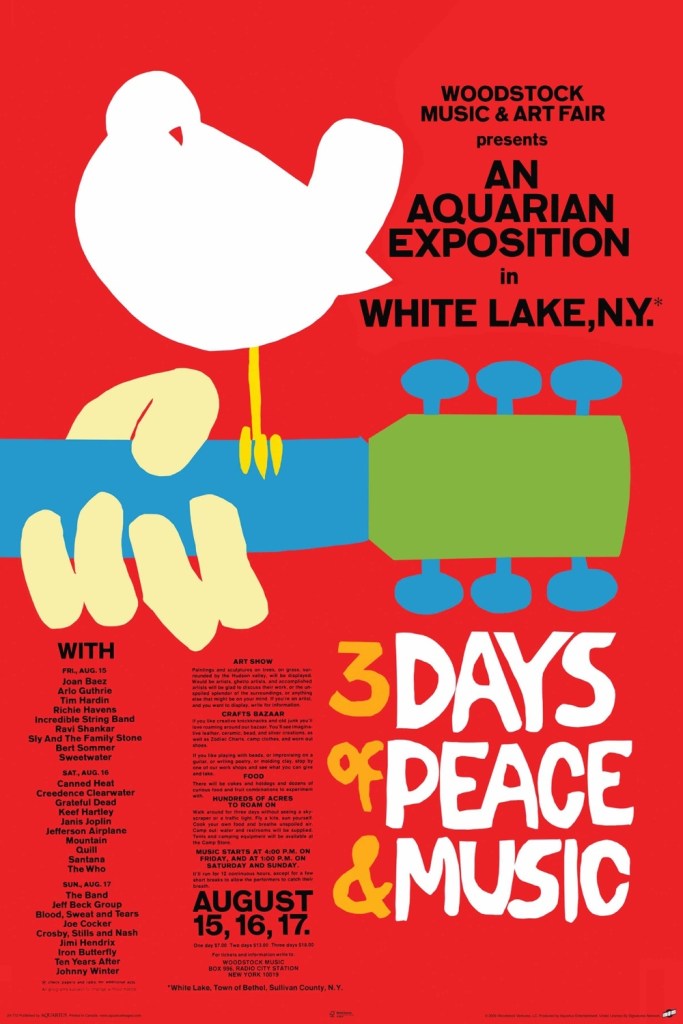Arnold Skolnick, who designed the iconic concert poster for the 1969 Woodstock festival, died on June 15 in Amherst, Massachusetts. He was 85. The cause of death was respiratory failure, according to his son Alexander Skolnick.
Videos by American Songwriter
Given only a few days to design what became one of the most iconic posters in pop culture history, Skolnick, who was 32 at the time, created a piece of imagery that conveyed the true “peace, love and music” message of the festival—a simple image of a guitar neck with a white bird perched atop and the words “3 Days of Peace & Music” in big lettering.
At the time, Skolnick was a freelancer, working for a Mad Men-like advertising agencies when John Morris, the production coordinator for the festival called him about the project. Sklonick got the assignment on a Thursday and turned the poster around by Monday, he said in a 2010 interview. “I brought it by to them on Monday afternoon,” said Skolnick. “It was just another job, but it became famous.”
Originally the assignment was given to David Edward Byrd, who had previously designed rock concert posters for the Fillmore East in New York City. The initial poster he designed for Woodstock was more psychedelic with flowers and hearts and featured a nude woman posing with an urn. The poster would have faced opposition from local businesses that wouldn’t feel comfortable hanging a poster of a naked woman in their window. Byrd’s design also didn’t allow for the names of performers to be listed, so the festival organizers moved on to Sklonick.
Inspired by paper cutouts that he saw 19th-century post-impressionist artist Henri Matisse had used, Skolnick began cutting out shapes of colored paper. “The whole thing came alive,” he said in 1976. “At first I thought of bird and flute, but the flute is really jazz, so I made it a guitar.”

As for the bird, Skolnick says many people thought it was a dove, but it was inspired more by the catbirds he was sketching on Shelter Island, New York. “I forgot to tell the printer that the beak should be black,” revealed Skolnick, “and so it’s a red beak.”
His writer friend, Ira Arnold, helped with the words, and the pair split the payment of $12,000. Skolnick put the money toward a house in Chesterfield, Massachusetts, and later moved to Northampton in 2015, where he lived until his death.
Not the biggest fan of rock and roll at the time, Skolnick seemed an unlikely candidate to create the poster, though he did attend Woodstock for one day and left before the rain started.
Born on Feb. 25, 1937, in Brooklyn, New York, Skolnick’s father Samuel was a linotype operator, and his mother, Esther was a secretary who operated a pre-digital calculator called the Comptometer for an ad agency. Drawing since he was 5 years old, Skolnick attended Pratt Institute and later studied under artist Edwin Dickinson at the Art Students League, both in New York.
Throughout his career, Skolnick continued working as an artist after creating one of the most famous concert posters in history and founded Imago Design, which specialized in art books, along with the publishing company Chameleon Books.
In addition to his sons Alexander and Peter from his first marriage to Irish Jay, Skolnick is also survived by his grandchildren Mose and Charna and sister Helene Rothschild.
“You can’t become an artist,” said Skolnick. “Either you are, or you’re not. It’s a gift.”
Photo by Shawn Patrick Ouellette/Portland Press Herald via Getty Images
